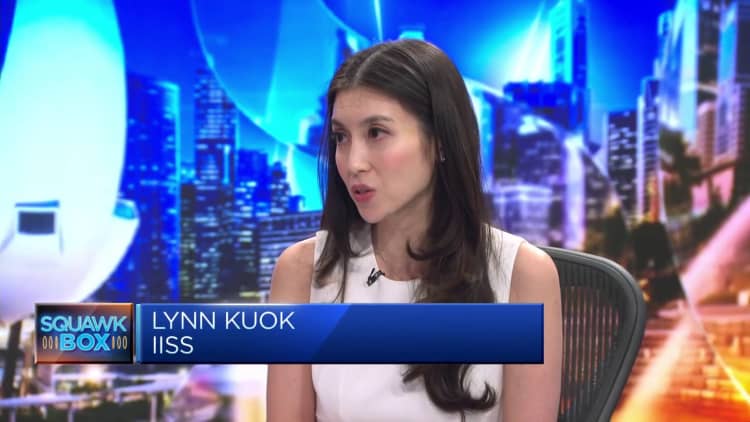
U.S. President Joe Biden holds a trilateral meeting with Japanese Prime Minister Fumio Kishida (right) and Philippine President Ferdinand Marcos (left) at the White House on April 11, 2024 in Washington, DC. The leaders of the three countries are holding their first trilateral summit in a show of solidarity as China’s assertiveness over the South China Sea escalates tensions in the region.
Andrew Harnick | Getty Images News | Getty Images
Long-standing tensions between China and its neighbors came into focus on Thursday, as leaders from the United States, Japan and the Philippines gathered at the White House to push back against Beijing’s increased pressure on Manila over the disputed South China Sea.
U.S. President Joe Biden’s administration is expected to announce new joint military operations and infrastructure spending in the former American colony as he hosts Philippine President Ferdinand Marcos Jr. and Japanese Prime Minister Fumio Kishida in Washington for the first trilateral summit.
The top topic at the meeting was China’s growing pressure in the South China Sea, although China’s pressure has escalated personal appeal Biden made the suggestion to Chinese President Xi Jinping last year.
The Philippines and China had several maritime clashes last month, including the use of water cannons and heated verbal confrontations. The dispute centers on Second Thomas Shoal, where Manila anchored a warship in 1999 to bolster its claims.

During a White House meeting with the three leaders, Biden confirmed that the 1950s-era mutual defense treaty binding Washington and Manila would require the United States to respond to armed attacks by the Philippines in the South China Sea.
“The United States’ defense commitment to Japan and the Philippines is ironclad,” he said.
Marcos successfully pushed Washington Resolve long-standing ambiguities Clarify that the treaty applies to disputes in this maritime area.
China claims almost all of the South China Sea, including its neighbors’ maritime economic zones. Second Thomas Shoal is located within the Philippines’ 200-mile (320-kilometer) exclusive economic zone. A 2016 ruling by the Permanent Court of Arbitration found that China’s sweeping claims had no legal basis.
Japan and China have island dispute East China Sea.
Chinese Foreign Ministry spokesman Mao Ning said that “China’s activities in the East China Sea and South China Sea are fully in compliance with international law” and that they are ready to solve the problem through “dialogue and consultation”, but criticized the United States and Japan for exacerbating tensions.
The United States plans to conduct joint coast guard patrols and joint maritime training activities in the Indo-Pacific region next year. A senior Biden administration official said Washington will also place “humanitarian relief supplies for disaster relief for Filipino civilians” at military bases in the Philippines.
More joint patrols Another U.S. official said drills were expected to be held in the South China Sea in the coming months, following last weekend’s drills in the United States, Australia, the Philippines and Japan.
The moves come after two prominent U.S. senators on Wednesday introduced a bipartisan bill Provide $2.5 billion to Manila to strengthen its ability to withstand Chinese pressure.
“A common tactic of China is to try to isolate its pressure targets, but the April 11 trilateral meeting made it clear that the Philippines is not alone,” said former top U.S. diplomat for East Asia under President Barack Obama. Daniel Russel said.
Leaders will also discuss wider regional challenges and economic development, as well as new investments in undersea cables, logistics, clean energy and telecommunications.facebook parents Yuan and ups is one of the companies announcing deals related to this visit.
A new air missile defense network announced on Wednesday involving Japan and Australia, with a focus on the Indo-Pacific region, is “probably still a few years away,” one official said.
Biden’s Global Infrastructure and Investment Partnership will support the Philippines’ new Luzon Corridor project, targeting infrastructure projects including ports, rail, clean energy and semiconductor supply chains.





